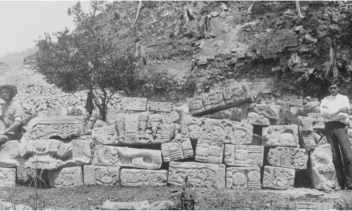
Located in western Honduras, the archaeological site of Copán is one of the most important sites of ancient Mayan civilization. Archaeological evidence shows that the earliest population of the Copán Valley dates back to 1500 B.C., but the first Maya-Cholan immigration is dated to around 100 A.D. Yax Kuk Mo, a Mayan leader, arrived in Copán in 427 A.D. and transformed Copán into one of the greatest Mayan cities of the Classical Maya Period (300-900 A.D.). During this time period, there were many changes in Copán society, including the development of the Classic Maya hieroglyphic writing system and their elaborate calendrical system. A significant aspect of this society was the Hieroglyphic Stairway Plaza, which contains more than 1,800 individual glyphics.
Built in two parts at two different times (710 and 755 A.D.), the Hieroglyphic Stairway Plaza contains the largest known Mayan inscription from ancient Mesoamerica. The inscription tells the official history of the Copán dynasty, with emphasis on its divine origins. However, when the Stairway was reconstructed in the 1950s, more than half of the carved blocks were not put back into their original positions, making it difficult to decipher the meaning of these glyphics. The bottom fifteen steps stayed in place. Although there have been inaccuracies as a result, the Hieroglyphic Stairway Plaza became a national symbol and a source of pride for Honduran society, playing a vital role in strengthening cultural identity.
Works Cited
Centre, UNESCO World Heritage. “Maya Site of Copan.” UNESCO World Heritage Centre, whc.unesco.org/en/list/129/.
Molloy, Joe. “The Hieroglyphic Stairway of Copán, Honduras.” Tegucigalpa, Honduras: J. Paul Getty Trust and Instituto Hondureño de Antropología e Historia, 2006.
“The Hieroglyphic Stairway.” Peabody Museum, Peabody Museum of Archaeology and Ethnology, 2020, www.peabody.harvard.edu/node/2079.
By Emilee Haines
